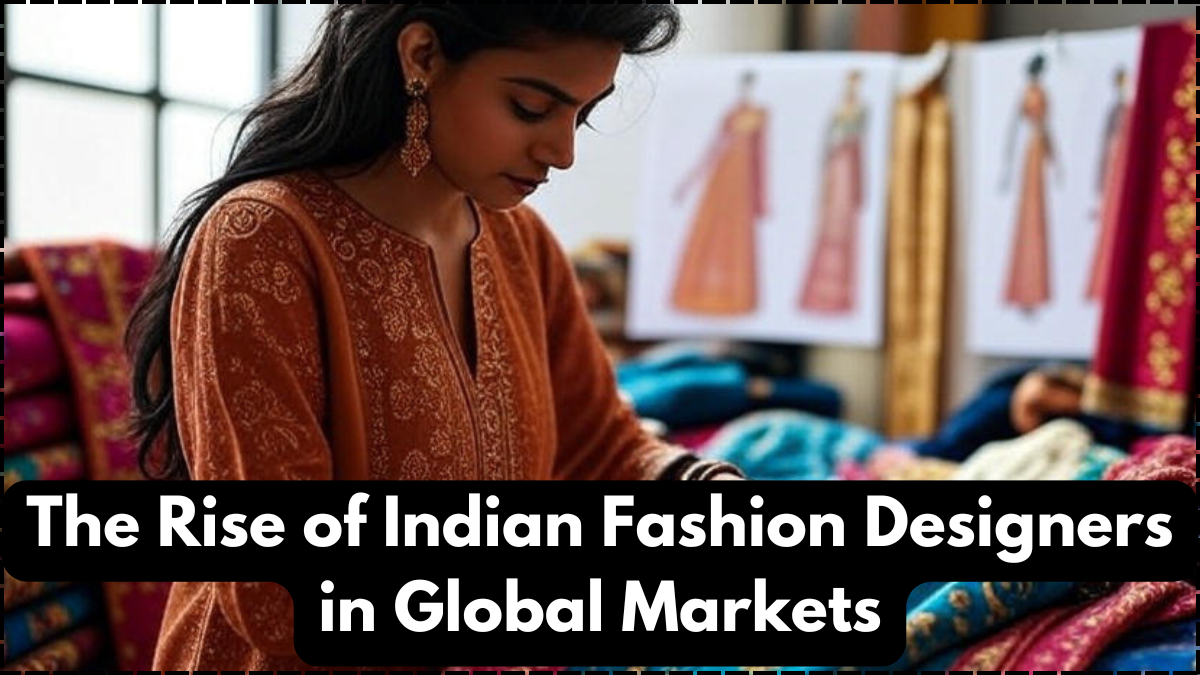Indian fashion designers are steadily claiming their space on the international stage, reshaping perceptions of luxury and style. For decades, Indian fashion was largely seen through the lens of traditional wear, but today designers are blending heritage with modernity to appeal to global audiences. Their success in Paris, Milan, New York, and London reflects India’s growing influence in global luxury markets. This transformation is more than fashion—it is cultural diplomacy, business strategy, and a celebration of India’s craftsmanship.

Indian Designers Entering Global Luxury Markets
The rise of Indian fashion designers in global fashion weeks highlights how Indian creativity is being embraced worldwide. Designers like Manish Malhotra, Sabyasachi Mukherjee, and Rahul Mishra have become synonymous with innovation that merges India’s embroidery, fabrics, and storytelling with contemporary silhouettes.
Key drivers of their entry into global luxury include:
- Showcasing at Paris, Milan, and New York Fashion Weeks
- Collaborations with international celebrities and brands
- Growing interest in sustainable fashion rooted in traditional Indian textiles
- Demand for unique luxury experiences over mass-produced fashion
This combination of authenticity and modern appeal has given Indian fashion a stronger position in luxury circles.
Factors Driving the Success of Indian Fashion Designers
The success of Indian fashion designers in global markets is not accidental—it is built on a combination of cultural richness, design innovation, and consumer trends shifting toward authenticity.
Major factors include:
- Heritage craftsmanship: Hand embroidery, weaving, and artisanal skills attract global buyers seeking exclusivity.
- Fusion styles: Blending traditional elements with Western cuts makes Indian designs versatile in global luxury markets.
- Sustainability: Designers focus on eco-friendly fabrics and ethical production, aligning with international values.
- Diaspora demand: Wealthy Indian communities abroad fuel demand for luxury Indian fashion at weddings and events.
Comparing Indian Designers with Global Luxury Houses
To better understand their position, a comparative look between Indian fashion designers and international luxury houses is insightful:
Designer/Brand |
Strengths in Global Luxury |
Unique Selling Point |
|---|---|---|
Sabyasachi (India) |
Bridal couture, global brand tie-ups |
Blend of heritage textiles and modern luxury |
Manish Malhotra (India) |
Celebrity collaborations |
Glamour and Bollywood-inspired global appeal |
Rahul Mishra (India) |
Paris Fashion Week recognition |
Sustainability and hand embroidery |
Gucci (Italy) |
Global luxury dominance |
Timeless luxury branding |
Dior (France) |
High fashion and exclusivity |
Iconic European craftsmanship |
This shows that Indian fashion designers are competing not just as niche creators but as strong contenders in the global luxury fashion landscape.
Challenges and Opportunities Ahead
While progress is visible, Indian fashion designers still face challenges in fully penetrating global luxury markets. Limited retail presence, competition from established European brands, and the need for stronger marketing strategies are hurdles. However, opportunities abound. Digital platforms, e-commerce, and collaborations with global influencers can amplify Indian designers’ reach.
Strategies for the future include:
- Expanding global retail stores for Indian luxury brands
- Partnering with international designers and fashion houses
- Leveraging social media to target luxury buyers worldwide
- Highlighting sustainable practices as a competitive advantage
Conclusion
The journey of Indian fashion designers from local ateliers to international runways reflects India’s growing presence in the global luxury industry. Their emphasis on heritage craftsmanship, sustainable practices, and innovative designs has redefined what luxury means in today’s world. As more Indian designers build global visibility, India is set to become not just a participant but a trendsetter in the future of fashion.
FAQs
Who are the leading Indian fashion designers in global markets?
Designers like Sabyasachi Mukherjee, Manish Malhotra, and Rahul Mishra are among the most recognized internationally.
How are Indian fashion designers contributing to global luxury?
They bring unique craftsmanship, sustainable practices, and fusion designs that appeal to international buyers seeking exclusivity.
What makes Indian fashion stand out in luxury markets?
The combination of traditional techniques, vibrant fabrics, and innovative modern styling sets Indian fashion apart.
What challenges do Indian designers face globally?
They face competition from established European luxury houses, limited global retail presence, and the need for larger marketing investments.
How can Indian fashion designers expand their global influence?
By collaborating with international brands, leveraging digital platforms, and opening more retail outlets in major fashion capitals.
Click here to learn more